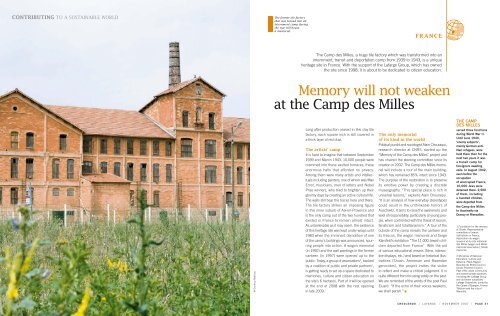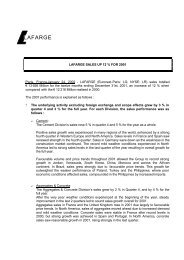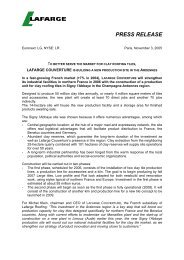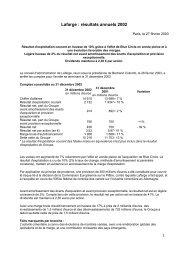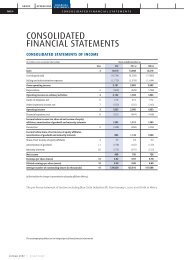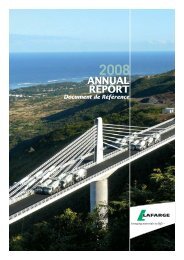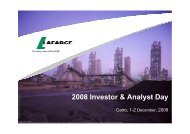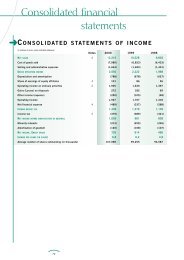The magazine - Lafarge
The magazine - Lafarge
The magazine - Lafarge
You also want an ePaper? Increase the reach of your titles
YUMPU automatically turns print PDFs into web optimized ePapers that Google loves.
CONTRIBUTING TO A SUSTAINABLE WORLD <strong>The</strong> former tile factory<br />
that was turned into an<br />
internment camp during<br />
the war will house<br />
a memorial.<br />
P A G E 3 6 | L A FA R G E | O C T O B R E 2 0 0 7 | C R E S C E N D O<br />
© Geoffroy Mathieu<br />
Long after production ceased in this clay tile<br />
factory, each square inch is still covered in<br />
a thick layer of red dust.<br />
<strong>The</strong> artists’ camp<br />
It is hard to imagine that between September<br />
1939 and March 1943, 10,000 people were<br />
crammed into these vaulted furnaces, these<br />
enormous halls that afforded no privacy.<br />
Among them were many artists and intellectuals<br />
including painters, one of whom was Max<br />
Ernst, musicians, men of letters and Nobel<br />
Prize winners, who tried to brighten up their<br />
gloomy days by creating an active cultural life.<br />
<strong>The</strong> walls still bear the traces here and there.<br />
<strong>The</strong> tile factory strikes an imposing figure<br />
in this inner suburb of Aix-en-Provence and<br />
is the only camp out of the two hundred that<br />
existed in France to remain almost intact.<br />
As unbelievable as it may seem, the existence<br />
of this heritage site was kept under wraps until<br />
1983 when the imminent demolition of one<br />
of the camp's buildings was announced, spurring<br />
people into action. A wagon memorial<br />
(in 1992) and the wall paintings in the former<br />
canteen (in 1997) were opened up to the<br />
public. Today, a group of associations 1 , backed<br />
by a coalition of public and private partners 2 ,<br />
is getting ready to set up a space dedicated to<br />
memories, culture and citizen education on<br />
the site’s 6 hectares. Part of it will be opened<br />
at the end of 2008 with the rest opening<br />
in late 2009.<br />
FR ANCE<br />
<strong>The</strong> Camp des Milles, a huge tile factory which was transformed into an<br />
internment, transit and deportation camp from 1939 to 1943, is a unique<br />
heritage site in France. With the support of the <strong>Lafarge</strong> Group, which has owned<br />
the site since 1998, it is about to be dedicated to citizen education.<br />
Memory will not weaken<br />
at the Camp des Milles<br />
<strong>The</strong> only memorial<br />
of its kind in the world<br />
Political pundit and sociologist Alain Chouraqui,<br />
research director at CNRS, started up the<br />
“Memory of the Camp des Milles” project and<br />
has chaired the steering committee since its<br />
creation in 2002. <strong>The</strong> Camp des Milles memorial<br />
will include a tour of the main building,<br />
which has remained 85% intact since 1943.<br />
<strong>The</strong> purpose of the restoration is to preserve<br />
its emotive power by creating a discrete<br />
museography. “This special place is rich in<br />
universal lessons,” explains Alain Chouraqui.<br />
“It is an analysis of how everyday stereotypes<br />
could result in the unthinkable horrors of<br />
Auschwitz. It aims to raise the awareness and<br />
level of responsibility, particularly of young people,<br />
when confronted with the threat of racism,<br />
fanaticism and totalitarianism.” A tour of the<br />
outside of the camp reveals the canteen and<br />
its frescos, the wagon memorial and Serge<br />
Klarsfeld’s exhibition “<strong>The</strong> 11,000 Jewish children<br />
deported from France”. With the aid<br />
of various educational means (films, interactive<br />
displays, etc.) and based on historical illustrations<br />
(Shoah, Armenian and Rwandan<br />
genocides), the project invites the visitor<br />
to reflect and make a critical judgment. It is<br />
quite different from focusing solely on the past.<br />
We are reminded of the words of the poet Paul<br />
Eluard: “If the echo of their voices weakens,<br />
we shall perish.” ■<br />
THE CAMP<br />
DES MILLES<br />
served three functions<br />
during World War II.<br />
Until June 1940,<br />
‘enemy subjects’,<br />
mainly German anti-<br />
Nazi refugees, were<br />
held there then for the<br />
next two years it was<br />
a transit camp for<br />
foreigners awaiting<br />
exile. In August 1942,<br />
even before the<br />
occupation<br />
of unoccupied France,<br />
10,000 Jews were<br />
detained there. 2,500<br />
of them, including<br />
a hundred children,<br />
were deported from<br />
the Camp des Milles<br />
to Auschwitz via<br />
Drancy or Rivesaltes.<br />
1 Foundation for the memory<br />
of Shoah, Representative<br />
committee of Jewish<br />
institutions in France,<br />
Association du wagon<br />
souvenir et du site mémorial<br />
des Milles (wagon and Milles<br />
memorial association), Shoah<br />
memorial.<br />
2 Ministries of National<br />
Education, Culture and<br />
Defence, PACA Region,<br />
Bouches du Rhône Council,<br />
Aix-en-Provence Council,<br />
Pays d’Aix urban community<br />
and several private sponsors,<br />
including the <strong>Lafarge</strong> Group<br />
and its former subsidiary<br />
<strong>Lafarge</strong> Couverture, joined by<br />
the Caisse d’Épargne, France<br />
Télécom and the city of<br />
Marseille.<br />
C R E S C E N D O | L A FA R G E | N O V E M B E R 2 0 0 7 | P A G E 3 7


